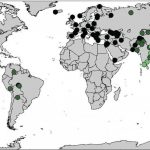Who were the Denisovans?0
- Ancient Archeology, From Around the Web
- September 9, 2022
These now-extinct humans lived as far back as 200,000 years ago.

These now-extinct humans lived as far back as 200,000 years ago.

For today’s Buddhist monks, Baishiya Karst Cave, 3200 meters high on the Tibetan Plateau, is holy. For ancient Denisovans, extinct hominins known only from DNA, teeth, and bits of bone found in another cave 2800 kilometers away in Siberia, it was a home.

The genomes of our closest relatives, Neanderthals and Denisovans, have been sequenced and compared with that of modern humans. However, most archaic individuals with high-quality sequences available have been female. In new research, a team of geneticists from the United States, China and Europe has sequenced the paternally inherited Y chromosomes from three Neanderthals and two Denisovans; comparisons with archaic and modern human Y chromosomes indicated that, similar to the maternally inherited mitochondrial DNA (mtDNA), the human and Neanderthal Y chromosomes were more closely related to each other compared with the Denisovan Y chromosome; this result supports the conclusion that interbreeding between early Homo sapiens and Neanderthals replaced the more ancient Denisovian-like Y chromosome and mitochondria in Neanderthals.

Rediscovery of missing finger bone shows slender fingertips unlike knobbed Neanderthal finger bones

A jawbone found in a cave on the Tibetan Plateau in China is providing surprising insights into Denisovans, the enigmatic extinct cousins to Neanderthals and our own species, including that they were pioneers at enduring high-altitude environments.

Humanity could have ended up very different if our ancestors didn’t meet.

This map shows the proportion of the genome inferred to be Denisovan in ancestry in diverse non-Africans.

At some point in the ancient past, Denisovans and modern humans mated and had children.

“This species first appeared more than a million years ago – and its face is very similar to that of modern humans”



